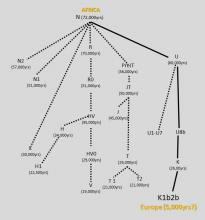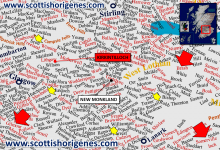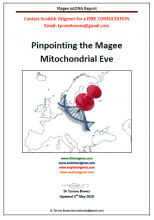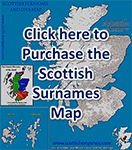You are here
PINPOINTING YOUR SCOTTISH MITOCHONDRIAL EVE!
 The challenge with modern commercial ancestral mtDNA testing is linking a specific maternal Eve with a precise geographical location. However, pinpointing an origin for one’s direct female ancestor (your maternal ‘Eve’) is far more challenging compared to identifying an origin for your direct paternal ancestor (your paternal ‘Adam’). This is because there is far less maternal DNA (mtDNA) to work with, and the surname is not usually passed maternally. So pinpointing the origin of your ‘Eve’ requires a very different approach; it involves identifying a common area of association for the earliest surnames and locations recorded by your genetic relatives who are revealed upon commercial Full Sequence mtDNA testing (if you have yet to test then order a full sequence mtDNA test).
The challenge with modern commercial ancestral mtDNA testing is linking a specific maternal Eve with a precise geographical location. However, pinpointing an origin for one’s direct female ancestor (your maternal ‘Eve’) is far more challenging compared to identifying an origin for your direct paternal ancestor (your paternal ‘Adam’). This is because there is far less maternal DNA (mtDNA) to work with, and the surname is not usually passed maternally. So pinpointing the origin of your ‘Eve’ requires a very different approach; it involves identifying a common area of association for the earliest surnames and locations recorded by your genetic relatives who are revealed upon commercial Full Sequence mtDNA testing (if you have yet to test then order a full sequence mtDNA test).
Anyone you match upon Full Sequence mtDNA testing (people who have also tested with the same company) share a common female ancestor with you! Your mtDNA matches are not random; they will all share the same specific mtDNA mutation (Haplogroup) with you; which determines your place on the mtDNA tree (example pictured). In many instances the appearance of your mtDNA Haplogroup can be dated by scientists in Academic labs. But a big advantage with commercial mtDNA testing is in the surnames and locations revealed by your maternal genetic relatives. As more and more people have taken the commercial Full Sequence mtDNA test; more and more of this type of ancestral detail has emerged. The surnames and locations revealed by your mtDNA genetic relatives are NOT RANDOM; they will lead back to a specific location allowing one to pinpoint one’s maternal Eve!
 In the accompanying Case Study I describe precisely how I pinpointed Ms Magee’s K1b2b Scottish Eve to New Monkland parish in Lanarkshire in South Central Scotland! You can download and read the full Magee mtDNA Case Study by CLICKING HERE.
In the accompanying Case Study I describe precisely how I pinpointed Ms Magee’s K1b2b Scottish Eve to New Monkland parish in Lanarkshire in South Central Scotland! You can download and read the full Magee mtDNA Case Study by CLICKING HERE.
To discover the origin of your Scottish Eve you must look to the ancestral detail recorded by your closest mtDNA genetic matches (revealed upon commercial ancestral Full Sequence mtDNA testing)! 
You can contact Scottish Origenes CLICK HERE for a FREE CONSULTATION on your DNA results (autosomal, Y-DNA or mtDNA) or to find out about a suitable painless DNA test for you.
Remember folks, I am a trained Scientist with over 20 years’ experience in both Academic and Industrial Labs. Always check the scientific qualifications of the blogger offering DNA advice. An honorary qualification is no substitute for decades of genuine awards and practical experience.






